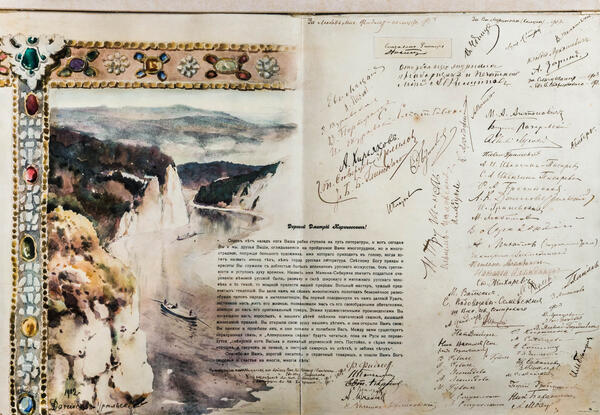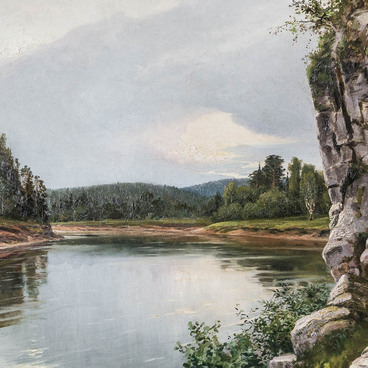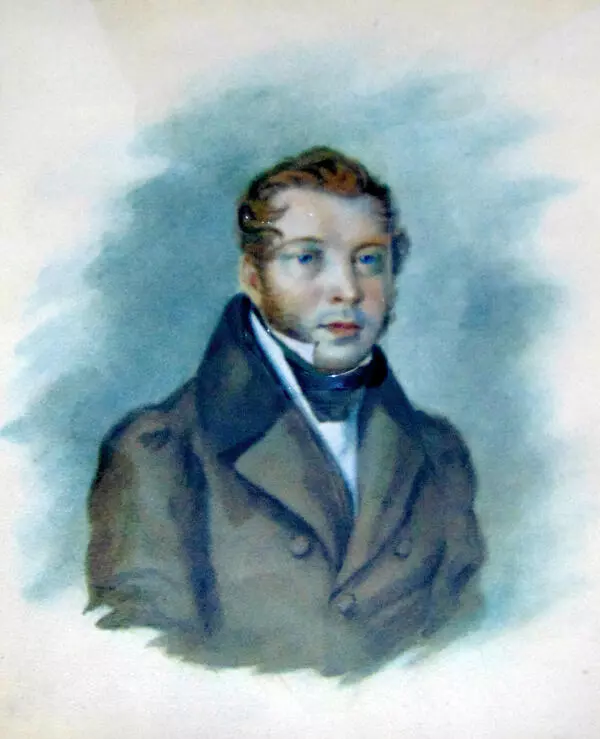In October 1912, Dmitry Mamin-Sibiryak was 60 years old. His friends and colleagues — critics, writers, and artists — formed an “anniversary committee”. They gave the writer a “congratulatory address” — a paper or cardboard postcard with a personal text. One can see a copy of it in the exhibition of the house-museum.
The document was kept by Mamin-Sibiryak’s last wife Olga Guvale. In 1916, she donated it to the Ural Society of Natural Science Lovers (USNSL). Later, the society collection became the Sverdlovsk Regional Museum of Local History, and the congratulatory address was in its funds. In 1946, the exhibit was handed over to the newly opened Mamin-Sibiryak House-Museum.
In the center of the postcard, there is a congratulatory text, which was signed by the members of the “anniversary committee”. A total of 86 people signed the address.
Researchers noted that Fyodor Fidler signed for nine people on the address. He was a close friend and biographer of Dmitry Mamin-Sibiryak. He did translations, taught, and organized a private “literary museum” devoted to writers of Russia and Germany.
However, the majority left autographs by themselves. Among them were the Russian novelist and playwright Ignaty Potapenko, the writer and symbolist poet Ivan Rukavishnikov, the sister of writer’s wife Sophia Guvale, the journalist Alexander Ivanchin-Pisarev, and many others.
On the left side, there is a watercolor by the artist Alexey Denisov-Uralsky. The landscape depicts the high rocky banks of the Chusovaya River, and the frame imitates the Ural stones. In the lower left corner, the author put the date and signature.
The artist and Mamin-Sibiryak were friends for several decades. They first met in 1883 at a meeting of the Ural Society of Natural Science Lovers.
A friendship was forged on the basis of an interest in minerals and rocks: Mamin-Sibiryak collected Ural gems, and Denisov-Uralsky created decorative stone sculptures. Later, the friends were united by their love for their native land and many common acquaintances.
According to memories, Alexey Denisov-Uralsky was always a welcome guest in the house of the Mamins. He often visited the writer after Mamin-Sibiryak moved from Yekaterinburg to St. Petersburg.
The document was kept by Mamin-Sibiryak’s last wife Olga Guvale. In 1916, she donated it to the Ural Society of Natural Science Lovers (USNSL). Later, the society collection became the Sverdlovsk Regional Museum of Local History, and the congratulatory address was in its funds. In 1946, the exhibit was handed over to the newly opened Mamin-Sibiryak House-Museum.
In the center of the postcard, there is a congratulatory text, which was signed by the members of the “anniversary committee”. A total of 86 people signed the address.
Researchers noted that Fyodor Fidler signed for nine people on the address. He was a close friend and biographer of Dmitry Mamin-Sibiryak. He did translations, taught, and organized a private “literary museum” devoted to writers of Russia and Germany.
However, the majority left autographs by themselves. Among them were the Russian novelist and playwright Ignaty Potapenko, the writer and symbolist poet Ivan Rukavishnikov, the sister of writer’s wife Sophia Guvale, the journalist Alexander Ivanchin-Pisarev, and many others.
On the left side, there is a watercolor by the artist Alexey Denisov-Uralsky. The landscape depicts the high rocky banks of the Chusovaya River, and the frame imitates the Ural stones. In the lower left corner, the author put the date and signature.
The artist and Mamin-Sibiryak were friends for several decades. They first met in 1883 at a meeting of the Ural Society of Natural Science Lovers.
A friendship was forged on the basis of an interest in minerals and rocks: Mamin-Sibiryak collected Ural gems, and Denisov-Uralsky created decorative stone sculptures. Later, the friends were united by their love for their native land and many common acquaintances.
According to memories, Alexey Denisov-Uralsky was always a welcome guest in the house of the Mamins. He often visited the writer after Mamin-Sibiryak moved from Yekaterinburg to St. Petersburg.




